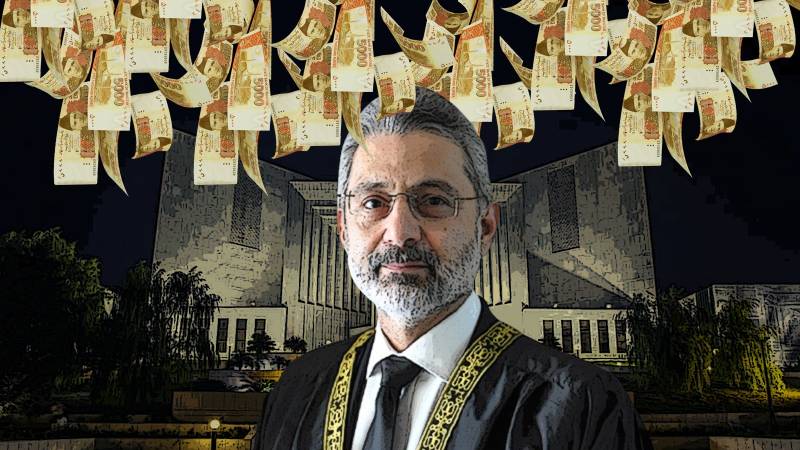
"کوئی مجھے سبز باغ دکھاتا ہے،
کوئی مجھے کالا باغ دکھاتا ہے!"
Justice MR Kiyani
These cryptic words from Justice MR Kiyani remind us of the twin threats facing judicial independence – allure and intimidation. At the height of his career, Justice Kayani was referring to two external dangers facing the judiciary: greed and bribery, the allure or "carrot," and fear, the iron-fisted "stick" of intimidation. Ayub Khan's regime, for instance, attempted to lure him with promises of elevation to the Supreme Court if he toned down his criticism of the military regime. Conversely, he faced threats of jail from the Nawab of Kalabagh, symbolising the stick-wielding executive.
While much attention has been paid to the stick-wielding executive branch's attempts to undermine judicial independence, the allure of perks and privileges often goes unnoticed. Pakistan's Constitution meticulously protects judicial independence through several mechanisms: security of the tenure, complex mechanism for removal from job, provision of budget as charged expenditure, and provision of salaries through a Presidential Order. However, the influence the executive wields through indirect financial benefits remains a concern.
Transparency in financial matters is essential to bolster the judiciary's integrity and trustworthiness, particularly in the case of the Supreme Court, where opacity raises questions about its independence. Justice MR Kiyani's remarks underscore the historical challenges judges face in maintaining their independence against external pressures.
Three recent incidents have drawn attention towards the problem that the "carrot" poses to judicial independence:
First, the issue of provision of interest-free loans for housing construction to judges of the Lahore High Court.
Second, the provision of plots to the judges of the superior judiciary.
Third is Mukhtar Ahmad’s four-year-long journey to get basic information about the perks of the judges.
At the Supreme Court, a bench, significantly composed of CJ Isa and Justice Minallah, has reserved the decision on Mukhtar Ahmad Ali's appeal before the Supreme Court. His four-year quest for transparency under Pakistan's Right of Access to Information Act sheds light on the judiciary's reluctance to embrace openness. His straightforward request for information on the Supreme Court's staff strength, vacant positions, staff status, and appointments against reserved seats faced denials, appeals, and challenges, culminating in the Supreme Court itself. This struggle exemplifies the urgent need for transparency in the judiciary's financial matters and the challenges faced by those advocating for openness within the institution.
It is essential to ascertain how taxpayer money is utilised, including judges' salaries and associated perks
Transparency vs Independence Debate
Some argue that transparency threatens judicial independence, but this perspective is flawed. Transparency, especially in financial matters, reinforces independence by ensuring accountability to the people. An independent judiciary must not only demand transparency from others but also lead by example. Moreover, denying transparency does not enhance the moral authority - the only real authority - of the courts; instead, it erodes trust. It raises questions about the financial integrity of the judges.
Therefore, the Supreme Court’s refusal to submit to the only constitutional committee, the Public Accounts Committee's attempts to audit the Supreme Court's budget, including salaries, perks, privileges, and plots for judges, evades fair logic. It is essential to ascertain how taxpayer money is utilised, including judges' salaries and associated perks.
Embracing transparency: Justice Qazi Isa's commitment
Justice Qazi Faez Isa and Justice Athar Minallah's commitment to transparency offers hope. Justice Isa has consistently advocated for openness in judicial affairs, from criteria for complaints against judges to transparent appointments through the Judicial Commission. CJ Isa’s petition for televised hearings of the Presidential Reference against him and subsequently ordering televised hearings of Supreme Court (Practice and Procedure) Act, 2023, demonstrates his dedication to transparency.
The debate over judges receiving perks and privileges beyond the Presidential Order, such as plots, underscores the critical importance of financial transparency. Chief Justice Isa and Justice Minallah advocate for transparency in determining judges' entitlements and have refused government-awarded plots. They argue that perks should adhere strictly to the Presidential Order to safeguard judicial independence.
Transparency and access to information serve as bastions against any potential encroachments on judicial independence. To strengthen this safeguard, it is paramount that citizens have the means to access information about judges' financial matters, including perks like plots. When the judiciary's financial matters remain veiled in secrecy, it creates fertile ground for undue influence, both direct and indirect.
Upholding legal frameworks, such as access to information laws and fundamental rights like the Right to Access to Information, ensures the transparent granting of perks and reinforces the public trust in the judiciary. The ongoing Mukhtar Ahmad Ali case highlights the urgency of these matters.
Acknowledging historical challenges and the importance of financial transparency is essential in understanding modern threats. Justice Isa's commitment to transparency aligns with Justice Kayani's concerns about the carrot-and-stick approach. Pakistan's judiciary has a unique opportunity to reinforce its commitment to transparency, enhancing public trust and guarding judicial independence against both direct and indirect threats.

